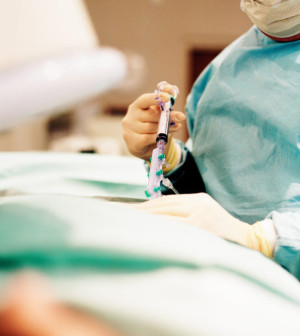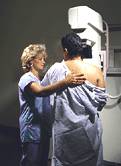- Navigating Your Midlife Crisis: Embracing New Possibilities
- City Raccoons Showing Signs of Domestication
- Mapping the Exposome: Science Broadens Focus to Environmental Disease Triggers
- One Week Less on Social Media Linked to Better Mental Health
- Your Brain Changes in Stages as You Age, Study Finds
- Some Suicide Victims Show No Typical Warning Signs, Study Finds
- ByHeart Formula Faces Lawsuits After Babies Sickened With Botulism
- Switch to Vegan Diet Could Cut Your Greenhouse Gas Emissions in Half
- Regular Bedtime Does Wonders for Blood Pressure
- Dining Alone Could Mean Worse Nutrition for Seniors
Radiation From Mammograms May Be Lower Than Thought


The low risks from radiation exposure during mammography screening may be even lower than experts have assumed, a new study contends.
The new research estimates that the radiation dose from a screening mammogram is anywhere from 20 percent to 35 percent lower than previously thought.
Why? Because past estimates did not account for the uneven distribution of different types of tissue in a typical woman’s breasts.
“The breast is composed of skin, fat and glandular tissue, and it’s the glandular tissue that’s potentially at risk from radiation during mammography,” explained lead researcher Andrew Hernandez, a Ph.D. candidate at the University of California, Davis.
Past estimates have assumed that fat and glandular tissue are distributed uniformly throughout the breast, Hernandez said. But, recent research has shown that the different tissue types are actually more “mixed” than that, he said.
For their study, Hernandez and his team created a model of breast anatomy based on CT scans from 219 women — who ranged in age, ethnicity and breast density.
“We estimate that glandular tissue is actually exposed to about 30 percent less radiation, on average, than assumed,” Hernandez said.
He was scheduled to present the findings Wednesday at the annual meeting of the American Association of Physicists in Medicine, in Anaheim, Calif. Studies reported at meetings are generally considered preliminary until published in a peer-reviewed journal.
So what do the findings mean for women? According to Hernandez, they might offer some reassurance, but they do not change any recommendations on breast cancer screening.
“We’re not saying this should change patient care, or that women should start breast cancer screening earlier because the radiation exposure is lower,” Hernandez said.
Robert Smith, vice-president of cancer screening for the American Cancer Society, agreed.
He said it has long been known that modern mammography uses low doses of radiation, and that any risk from regular screening would be greatly outweighed by the benefit of catching breast cancer early.
“In this study,” Smith said, “they’re estimating that a very low risk is even lower than we’ve thought.”
With mammography screening, Smith said, the main potential harm has nothing to do with radiation: The real concern centers on “over-diagnosis” and “over-treatment” — the potential for catching tiny tumors that would never have progressed to threaten a woman’s life, and then giving her unnecessary treatment.
In particular, there is controversy about whether the benefits of screening outweigh the harms for women in their 40s.
The American Cancer Society and other groups recommend that women at average risk of breast cancer begin having yearly mammograms at age 40. But the U.S. Preventive Services Task Force — an independent panel that advises the government — recommends starting at age 50, then having mammograms every other year.
If women want to begin screening earlier than that, the task force says they should discuss the pros and cons with their doctor before making a decision.
The new findings, according to Smith, should offer women extra reassurance that the radiation dose from mammography is quite low. But they won’t affect any general recommendations on screening, he said.
More information
The American Cancer Society has more on mammography and radiation.
Source: HealthDay
Copyright © 2025 HealthDay. All rights reserved.










